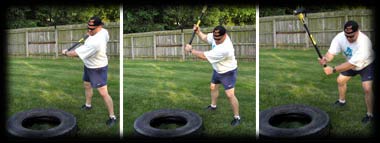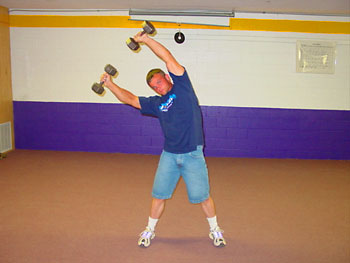|
It's really just the ability to move efficiently. Think of watching someone who is stiff on the dance floor vs a proficient dancer. Many athletes are like the "stiff" dancers. They don't move well on their feet. The most basic drills would be stuff like jump rope, agility drills, reaction drills, dot drills, and low intensity hops. You can incorporate changes of direction with all these patterns. Then you simply add force to these movements. To give you one example of a progression initially you'd go from hopping smoothly over a rope (jump rope) to hopping smoothly back and forth over a knee high barrier, to doing the same thing on one leg, to eventually doing the same over a waist high barrier while rotating 180 degrees with each jump - without any effort and without a sound at impact. That's just one example of a progression there are many more and you can probably think of your own if you get creative. Gifted athletes tend to move better and this is evident from an early age. Whether it's from genetics or from being involved in a myriad of activities as a youth is variable. If one can't move proficiently then you need to go back and use specific training to make up for the lost time. As for books on the subject, - there aren't any that I am aware of. More Strength training or power training? - Stay tuned for an upcoming article where I'll go into detail on that question, but for now realize that an increase in strength often will transfer directly to an increase in power and the potential for strength gains is very large and can occur over a long period of time. Specific power training will give increases over a short period of time and then a quick plateau. If your strength is plateaued then use a short block of power training to progress. If your power training (or displays of power) plateau, even though you're specifically training that quality, then get stronger. Both are necessary, but over the long run, training for strength will usually give you the biggest buck for your training dollar.
Q: What exercises do you suggest for targeting the abdominal region of the core for enhanced athletic ability (jumping, change of direction, first step, etc.)? Right now, I focus on russian trunk twists, full contact twists, pikes, and overhead squats...are there any other exercises that either target different areas or work them in different ways that are more sport-specific? The exercises you mention are good and I use them all. Here are some more that I use. Sledgehammer tire strikes, saxon side bends, hip abduction side bends, Janda situps, and v-ups. Also don't discount the value of standard hard and heavy training like squats, deadlifts, etc. Training your abs is not absolutely necessary to have a defined midsection. The ab muscles really won't grow that much regardless of how often or how hard you train them so train your abs for strength and performance and get the fat off with your diet.
I would say that behind the neck military presses and bench presses done with the elbows out will eventually wreck the shoulders of even the healthiest cat. In fact I think that if you directly train shoulders with lots of overhead pressing movements you will eventually run into some problems, particularly if your flexibility and muscle balance is off kilter - at least thats been my experience. Overhead pressing doesn't have to be totally eliminated but relegate it to shorter blocks throughout the year. I incorporate direct overhead pressing maybe 1/4 of the year. In place I recommend various forms of laterals and lots of rear delt work and mid-trap work. The delts get hit quite a bit from any sort've pushing and pulling work so really one could get by without any shoulder work period.
Q: I used to play volleyball in college, now I'm almost 30 yo and play 1-2 a week (pick up and league). I started dead lifting and I can pull about 2.25 of my bodyweight now. I follow more or less Power to the People by Pavel Tsatsouline (4-5 times a week, 2 sets 5 reps, 5 minute breaks). This program really worked for me as far as 1 rep max. I sometimes do full jump squats with about 70lbs for power. But just a few reps, so I don't overtrain myself. I made great progress in standing jump (volleyball blocking) - about 6 inches. But only about 2 inches in 2 step approach jump (spike). I understand that my starting strenght is ok and have to work on speed. How to transfer my strenght to vertical jump? Can you tell me what exercises I should do? I don't think I get enough jumping just by playing volleyball 1-2 a week. I'm looking for something simple and basic. Would I benefit from sprints? Thank you A: It does make sense that the deadlifts would improve your standing jump moreso then your approach jump because the standing jump relies more on starting strength and the deadlift is a phenomenol starting strength exercise. I was about to suggest either depth jumps or drop jumps but then you said you play volleyball twice a week. I don't know how hard you play but most of the time that would be quite a bit of reactive training. So you're deadlifting 4-5 times per week and playing volleyball 1-2 times per week. If your nervous system is fatigued the movements that require more speed will show a decrease prior to those that require more strength. For example, if you're fatigued you might not notice any decrease in the amount of weight you can lift but your top speed sprint might be negatively affected. In your case the approach jump requires more speed then the standing jump. My guess is that you're in a minor state of fatigue. Drop the volume of the deadlifts to 2 days a week for 2 weeks and see what happens. Then when you come back you can do deadlifts 3 days per week just like you're doing right now then do the following for 6 sets of 5 reps once per week: Measure your vertical jump then Stand on an 18 inch box and do a depth jump and measure how high you can jump immediately after ground contact. If the depth jump is higher then your vertical jump then once a week do 6 sets of 5 depth jumps from the 18 inch box. If your vertical jump is lower then your depth jump then jack the box up to around 35 inches and just do drop jumps performing just the landing phase of a depth jump. Land in an athletic stance on the balls of your feet and "freeze" the impact. Don't let your heels touch the ground. Either of those solutions should remedy your problem as they train the qualities required in the approach jump. Do one or the other (depth jumps or drop jumps) but not both. -Kelly
|


